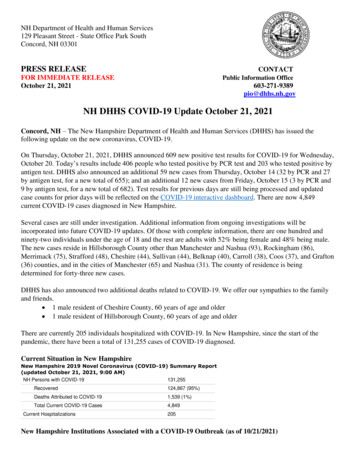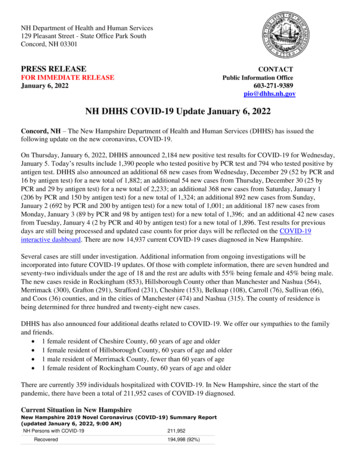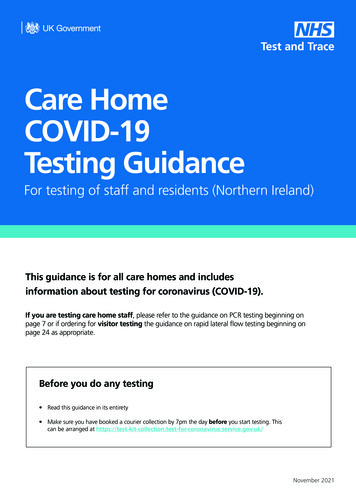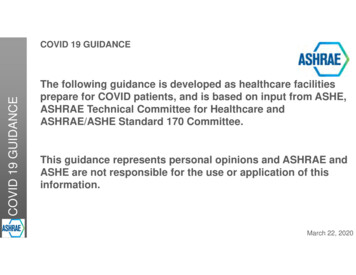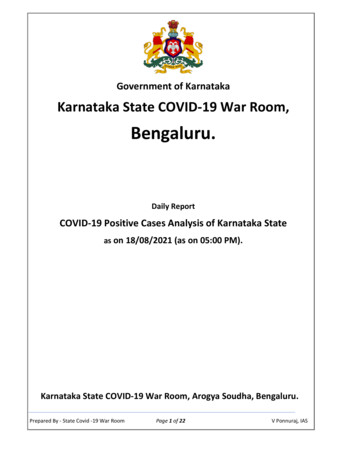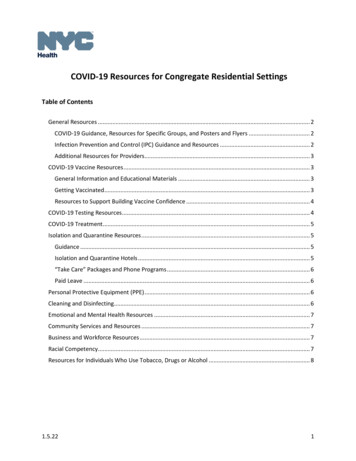
Transcription
GUIDANCE SUMMARYWA STATE COVID-19 VACCINE PRIORITIZATION GUIDANCEAND ALLOCATION FRAMEWORKThe Washington State Department of Health has developed this guidance for COVID-19 vaccine allocation and prioritization to facilitate harmonizedplanning for distribution across Washington State. This guidance is the result of several months of engagement with expert groups and communitypartners to gather input and ideas. Given current information and federal guidance, we are providing guidance on Phases 1 through 4 that incorporatesthis input while staying aligned with the principles and criteria noted below. The guidance has and can continue to be updated based on: New information from clinical trialsNew federal guidance and vaccine recommendationsOngoing feedback from impacted communities, partners, sectors, and industriesIn this guidance, population groups overlap and there are individuals who fit into multiple categories. When this is the case, the higher phase should takeprecedence. Also, the order of the populations does not suggest any type of prioritization or risk stratification. In all circumstances, although reinfectionappears uncommon during the initial 90 days after symptom onset, prior confirmation of COVID-19 infection will not exclude any individual from eligibilityfor COVID-19 vaccine and serologic testing is not being recommended prior to vaccination. Vaccines should be administered according to age groups forwhich the specific vaccine is authorized (e.g., Pfizer for 16 and over and Moderna for 18 and over).GOAL: To reduce severe morbidity and mortality and negative societal impact due to the transmission of SARS-CoV-2ETHICAL PRINCIPLES Maximum benefit Equal concern Mitigation of health inequitiesPROCEDURAL PRINCIPLES Fairness Transparency Evidence-basedCRITERIA Risk of acquiring infection Risk of severe morbidity and mortality Risk of negative societal impact Risk of transmitting infection to othersTo request this document in another format, call 1-800-525-0127.Deaf or hard of hearing customers, please call 711 (Washington Relay) or email civil.rights@doh.wa.gov.
Phase Eligibility TimingThe table below outlines groups who are currently eligible vs. projected timing for future eligible groups. These future plans are tentative and are subjectto change depending upon vaccine supply and demand.Phase1A1B tier 1When it will openCurrently open (Dec 14,2020)Currently open (Jan. 18,2021)1B tier 2Currently open (March17, 2021)1B tier 3 & 4Currently open (March31, 2021)Who is in it See prioritization guidance 2, 3Opens April 15, 2021 See prioritization guidancePre-kindergarten through 12th grade educators and staff (added March 2)Child care staff (added March 2)High-risk critical workers in certain congregate settingsPeople age 16 or older who are pregnantPeople age 16 or older who have a disability that puts them at higher riskPeople 16 years or older with 2 or more comorbidities or underlyingconditionsPeople 60 years and olderPeople, staff and volunteers in certain congregate living settings –specifically, correctional facilities, congregate settings where peopleexperiencing homelessness live or access services, and group homes forpeople with disabilitiesOther at-risk critical workers in certain congregate settings – specifically,restaurants/food services, manufacturing, and constructionAll people age 16 years and older not already coveredPhase 1a - Tier 1Overarching Groups: High-risk workers in health care settings (clinical judgment should be applied to identify who is at greatest risk using the guidance below)High-risk first responders (clinical judgment should be applied to identify who is at greatest risk using the guidance below)Residents and staff of nursing homes, assisted living facilities, and other community-based, congregate living settings where most individualsover 65 years of age are receiving care, supervision, or assistancePhase 1a focuses on (a) high-risk workers in health care settings and high-risk first responders in order to protect our medical care response capacity and(b) residents and staff of nursing homes, assisted living facilities, and other community-based, congregate living settings where most individuals over 652
years of age are receiving care, supervision, or assistance aiming to avoid hospitalizations, severe morbidity, and mortality. The table below identifies thedesired objectives and guidance regarding what individuals would be prioritized for vaccine allocation in this phase. We provided recommendations thatclosely align with the Advisory Committee on Immunization Practices (ACIP) and initially include risk stratification given limited vaccine .CDC provided initial COVID-19 vaccine supply projections for the first two months. Assuming Washington state receives approximately 2 percent of thetotal projections (Washington’s approximate proportion of total U.S. population), our state was expected to receive between 150,000 to 350,000 doses inthe first month and between 500,000 to 1 million doses in the second month (inclusive of second doses). Also note that many residents of long-term carefacilities will be served via a federal pharmacy program that began in late December and draws down from the Washington state vaccine allotment. Givenlimited vaccine, sub-prioritization and sequencing of distribution to health care personnel was initially necessary. Furthermore, agencies have beenencouraged to consider staggering vaccine schedules of teams to avoid potential clustering of worker absenteeism related to systemic reactions.Beyond ACIP, this guidance was developed based on input and review by a number of experts including Washington advisory groups (Vaccine AdvisoryCommittee, Disaster Medical Advisory Committee, COVID-19 Science Advisory Working Group, Association for Professionals in Infection Control), healthcare providers, and local health jurisdictions (including health officers).PHASE 1A-1OBJECTIVEPHASE 1A-1 GUIDANCETo protect those athighest risk ofexposure, tomaintain afunctioning healthsystem, and toprotect highlyvulnerablepopulationsIn the context of limited vaccine, this guidance includes the following sub-prioritization considerations: Personnel without known infection in prior 90 daysWorkers in sites where direct patient care is being frequently delivered to confirmed or suspected COVID-19 patients, including siteswhere suspected patients are directed for COVID testing and careo Example setting: hospital sites managing suspected/confirmed COVID patients; emergency departments; urgent care; clinics(walk-in, respiratory); home; isolation and quarantine facilityo Examples types of workers: health care workers; technicians; security; environmental, janitorial, and facility staff; non-remotetranslators; counselors; home health aides, caregivers, and companionsWorkers frequently performing high-risk exposure procedures with suspected or confirmed COVID-19 patientso Example procedures: endotracheal or cough inducing intubation; cough induction or cough inducing procedure (e.g.,nasogastric tube); bronchoscopy; suctioning; turning the patient to the prone position; disconnecting the patient from aventilator; invasive dental procedures and exams; autopsies; respiratory specimen collection; cardiopulmonary resuscitation;upper endoscopy; laparoscopic surgery; placement of chest tubes for pneumothoraxWorkers exposed to/handling potentially SARS-CoV-2 containing specimensCOVID-19 testing site staff at high risk of exposure to suspected COVID-19 patientsFirst responders at high risk of exposure to suspected or confirmed COVID-19 patients via high public exposure and procedureso Licensed emergency medical service frontline staff regardless of agency (e.g., fire, ambulance, hospital)o Emergency workers providing patient transport/ambulatory support regardless of agencyo Personnel working in the field to provide oversight of these emergency medical service positionsWorkers with elevated risk of acquisition/transmission with populations at higher risk of mortality or severe morbidity3
Workers at long-term care facilities and other community-based, congregate living settings where most individuals over 65years of age are receiving care, supervision, or assistance (e.g., healthcare, environmental facility management, counselors,dining staff, etc.)o Home health aides, care aides, caregivers (paid or unpaid), companions, etc.o Workers with patients undergoing chemotherapy, chronic renal disease, dialysis, etc. Workers (including pharmacists and occupational health staff) administering vaccines to Phase 1a and 1b -----------------------Residents and staff of long-term care facilities and other community-based, congregate living settings where most individuals over 65 yearsof age are receiving care, supervision, or assistance and are unable to reside independently in the community:o Example: skilled nursing facilities – facility engaged primarily in providing skilled nursing care and rehabilitation services for residentswho require care because of injury, disability, or illnessExample: assisted living facilities – facility providing help with activities of daily living; residents often live in their own room orapartment within building/group of buildingsExamples of possible settings: adult family homes; group homes for people with disabilities (physical, developmental, intellectual);mental/behavioral health institutions; residential homeless sheltersWhere sub-prioritization is needed, consider: Skilled nursing facilities caring for the most medically vulnerable residents and of congregate nature so they face the joint risk factorsof severe disease/mortality and transmission due to their living settingsAfter skilled nursing facilities, consider broadening to other facilities, including:o Assisted living facilities and adult family homeso Residential care communitieso HUD 202 low-income senior housingo Intermediate care facilities for individuals with developmental disabilitieso State Veterans HomesPhase 1a (Tier 1) Additional Guidance We specifically use the terminology “workers in health care settings” and not “health care workers” because health agencies should consider thefull spectrum of workers who might fit these conditions. Health care agencies should consider all types of staff (e.g., contracted, part-time,unpaid/volunteer) and the spectrum of staff who provide services (e.g., ambulatory, direct patient care, support services). ACIP provides similarguidance regarding defining healthcare personnel.1Specifically, for caregivers: eligible caregivers (licensed, unlicensed, paid, unpaid, formal, or informal) who support the daily, functional and healthneeds of another individual who is at high risk for COVID-19 illness due to advanced age, long-term physical condition, co-morbidities, ordevelopment or intellectual disability. For the caregiver to be eligible, the care recipient:o Must be someone who needs caregiving support for their daily, functioning, and health needso Can be an adult or minor child. For dependent minor children, the caregiver is eligible if that child has an underlying health condition ordisability that puts them at high risk for severe COVID-19 illness. For example: a caregiver of a minor child with Down syndrome.4
Special attention should be paid to workers in health care settings who are at high risk of exposure and may have inconsistent or limited use ofPPE as well as those working in settings with inadequate environmental controls for recommended air exchange.Phase 1a - Tier 2 (after completion of Tier 1)Overarching Group: All other workers at risk in health care settingsThe definition of health care settings as defined by the CDC refers to places where health care is delivered and includes, but is not limited to, acute carefacilities, long term acute care facilities, inpatient rehabilitation facilities, nursing homes and assisted living facilities, home healthcare, vehicles wherehealthcare is delivered (e.g., mobile clinics), and outpatient facilities, such as dialysis centers, physician offices, and others.PHASE 1A-2 OBJECTIVEPHASE 1A-2 GUIDANCETo protect those at highest risk ofexposure, to maintain a functioninghealth system, and to protect highlyvulnerable populationsAll other workers at risk to COVID working in health care settings Workers who are at risk of acquisition or transmission of COVID because they are interacting in close proximity (lessthan 6 feet) with patients, co-workers, or specimens and are unable to remain socially distant (i.e., not include remoteworkers)Phase 1a (Tier 2) Additional Guidance We specifically use the terminology “workers in health care settings” and not “health care workers” because health agencies should consider thefull spectrum of workers who might fit these conditions. Health care agencies should consider all types of staff (e.g., contracted, part-time,unpaid/volunteer) and the spectrum of staff who provide services (e.g., ambulatory, direct patient care, support services).Across Washington, it is important that health care systems actively reach out to and provide access to COVID-19 vaccination for communitybased health care workforce outside their systems and in their community. This includes other health care providers, school nurses, andbehavioral health providers, etc., in order to compete this phase and ensure we have a protected healthcare system.Phase 1bPhase 1b phase includes people who are high to moderate risk against the four risk criteria listed below stratified in different tiers given limited vaccinesupply: Risk of acquiring infectionRisk of severe morbidity and mortalityRisk of negative societal impact5
Risk of transmission to othersIn addition, we have applied equity as a cross-cutting lens and considered situations when certain groups are disproportionately affected due to socialfactors and/or other systemic inequities to mitigate for these factors.Phase 1b - Tier 1Overarching Groups: All people 65 years and olderPeople 50 years and older in multi-generational householdsWorkers in childcare settingsPre-kindergarten-12th grade educators and staffThe first two objectives of this tier focus on protecting those who are driving hospitalization and face high rates of severe morbidity and mortality in orderto reduce the burden on hospitals that keeps us in an emergency state. We also want to recognize that there are older adults and elders who may bevulnerable and unable to live independently similar to those in community-based, congregate care settings (Phase 1a) but their families care for them athome. In addition, we recognize that many families - especially those disproportionately affected by COVID - live in multi-generational homes that put theolder adults and elders in the household at significantly higher risk for acquiring infection. Because these individuals are among disproportionatelyaffected groups, they are also at risk for higher rates of severe morbidity and mortality.PHASE 1B-1 OBJECTIVEPHASE 1B-1 GUIDANCETo prevent hospitalization and ratesof severe morbidity and mortalityAll people 65 years and older (about half of whom have co-morbidities that increase risk for severe outcomes if infected withCOVID)To prevent acquiring infection,hospitalization, and rates of severemorbidity and mortalityPeople 50 years and older in a multigenerational (2 or more generations) householdThese individuals would be at risk either due to: Vulnerability – specifically, an older adult or elder who cannot live independently and is being cared for by a relative or inhome caregiver or being cared for by someone who works outside the homeRisk of exposure – specifically, an older adult or elder who is living with and taking care of kinship (along the lines of agrandparent with a grandchild)This group does not include an older adult who is able to live independently and is taking care of the individual’skinship/childrenOn March 2, 2021, Gov. Jay Inslee and the Washington State Department of Health in accordance with a federal directive added another group to this tier– specifically, workers in child care settings and pre-kindergarten through 12th grade educators and staff. This group was initially in Tier 2 with otherworkers at high risk in a congregate setting. However, not only do they face the risks of acquisition and transmission (note: there is growing evidence that6
older kids have higher risk of transmission) but remote care and education is also associated with very high risk of negative societal impact. There is strongevidence regarding the negative impact remote schooling is having on students in pre-kindergarten through 12th grade regarding educationaladvancement and access to meals and support services for children, which disproportionately affects low-income families.PHASE 1B-1 OBJECTIVEPHASE 1B-1 GUIDANCETo protect those who are at high riskof exposure given the nature ofwork, to reduce negative societalimpact by maintaining criticalinfrastructure for social andeconomic systems, and to reduce thenegative societal impact on familiesand children (that disproportionatelyaffects low-income families)Workers in child care settingsPre-kindergarten through 12th grade educators and staff This category should consider the full spectrum of workers including administrators, environmental services staff,maintenance workers, school bus drivers, paraeducators, and all of who are essential to child care and education.Specifically, this group includes those who face substantially high risk of exposure given work conditions because they areoperating in a congregate setting interacting with co-workers or youth over extended periods of time.Eligible child care includes:o Licensed family home child care providers, and the family members living in their home.o License-exempt family, friends, and neighbor providers that accept Working Connections Child Care subsidy.These in-home providers can serve up to 6 children.o ECEAP, Washington’s state-funded preschool providers. This is similar to the national Head Start program, whichis named in the directive.o License-exempt school-age and youth development providers who have been providing care to school-agechildren since the pandemic began and schools were closed. As schools moved to online and hybrid models,these programs have continued to provide child care for school-age children.Attention should be given to the specific programs that reach children with special health care needs, individualeducational plans, technological gaps, and migrant education programs.Phase 1b - Tier 2Overarching Groups: High-risk critical workers who work in certain congregate settingsPeople who are pregnantPeople with a disability that puts them at high riskPhase 1b Tier 2 includes a subset of high-risk critical worker groups 1 who work in certain congregate settings. Occupational risk factors for COVID includesetting (time inside vs. outside), proximity (to co-workers and/or customers), type of contact (physical, surface), duration, daily number of contacts,1See Washington Essential Critical Infrastructure Workers for most up-to-date list of essential worker groups7
capability to assess possible infection (screening), consistent access to/ability to use protection, cleaning (frequency), and barriers to healthcare access.The course of the pandemic in Washington state indicates that specific groups of workers operating in congregate settings—such as, agricultural workers,food processing, and incarceration facilities — have experienced significantly elevated rates of infection given the nature of their working and/or livingconditions. In addition, the working and living conditions contribute to transmission at work and in the community. Other critical worker groups areincluded in future phases.PHASE 1B-2 OBJECTIVEPHASE 1B-2 GUIDANCETo protect those who are at high risk ofexposure and transmission given thenature of working and living conditions,to prevent hospitalizations and rates ofsevere morbidity and mortality, and toreduce negative societal impact bymaintaining critical infrastructure forsocial and economic systemsCertain critical workers with significantly high risk of exposure and transmission in certain congregate settingsCongregate setting refers to an environment where individuals work and/or live in an enclosed space where they areinteracting with a high volume of people (i.e., supermarket) over extended time and not able to consistently socialdistance (i.e., be more than 6 feet apart).This does not include all critical worker groups but just a subset outlined below. This subset is focused on workers whoare working in a congregate/enclosed setting working within 6 feet of other workers over an extended time (3 or morehours in 24-hour day). Therefore, workers who are able to socially distance, work remotely or work off-site not in acongregate setting would not be included. Specific groups and guidance are outlined below: Congregate agriculture – specifically those who work and/or live in a congregate setting interacting with a highvolume of co-workers (vs. animals) over extended periods of time (i.e. 3 or more hours in a 24-hour day).Relevant roles are more likely to include crop selection, production and packaging vs. equipment maintenanceCongregate food processing – specifically those who work and/or live in a congregate setting interacting withhigh volume of co-workers (vs. animals) over extended periods of time (i.e. 3 or more hours in a 24-hour day).Also includes those working in fishing vessels.Workers in congregate grocery stores or food banks - specifically those who work in a congregate settinginteracting with high volume of co-workers over extended periods of time (i.e. 3 or more hours in a 24-hour day).We encourage considering prioritizing retail stores of higher density/volume (e.g., grocery stores, higher volumeretail/convenience stores providing groceries) vs. where people are more able to be socially distant (e.g.,wineries, coffee shops).Congregate staff in correction facilities, prisons, jails, detention facilities, and court facilities – specifically thosewho are interacting with high volume of individuals in a congregate interior setting over extended periods oftime (i.e. 3 or more hours in a 24-hour day). We encourage considering the spectrum of staff (e.g. facilitymanagement, security, counselors) who fit this exposure criteria.Congregate public transit - specifically those who work in an enclosed (vs. outdoor) congregate settinginteracting with high volume of co-workers or general public over extended periods of time (i.e. 3 or more hoursin a 24-hour day) to facilitate the transport of people. Settings may include bus, train, ferry, airport, and otherhigh density transportation settings – or lower density settings where individuals are tightly constricted over anextended time, specifically taxies, limos and ride-share private vehicles over 4 people. It does not include thosewho can work remotely or in an office where they can practice being socially distant.8
First responders not covered by an earlier phase or tier - specifically those who work in a congregate settinginteracting with high volume of co-workers or general public over extended periods of time (i.e. 3 or more hoursin a 24-hour day). This first responders group includes firefighters, law enforcement, social workers, publichealth, and other people playing similar roles (e.g., tactical teams, some providers for homeless services)responding to public health and safety. It does not include administrators or those who can work remotely,except for public health and first responder functions critical for maintaining the COVID-19 pandemic responseand continuity of operations.Early learning and child care program workers that are permitted to operate under DOH guidance for child care,youth development, and day camps that were not covered in 1B-1.Phase 1b Tier 2 also includes a subset of people with underlying conditions that put them at increased risk for severe illness if infected with COVID-19leading to hospitalization, morbidity, and mortality that are anticipated to face challenges accessing care.PHASE 1B-2 OBJECTIVEPHASE 1B-2 GUIDANCETo prevent hospitalization and rates ofsevere morbidity and mortality Pregnant peoplePeople with a disability that puts them at high risk. This includes individuals with Down syndrome, a developmentaldisability, or an intellectual disability, or who are deaf/hard of hearing, blind/low-vision, or deafblind, AND thatdisability or an underlying medical condition increases their risk for severe outcomes per the CDC’s list of theconditions that put people at increased risk of severe illness from COVID-19 (note: this is a living document that maybe updated as science evolves). This includes three types of groups - specifically:o People with a physical or intellectual disability where they cannot use protective measures (e.g., severeautism, epilepsy)o People with a physical or intellectual disability that is clinically associated with severe outcomes if infectedwith COVID (e.g., down syndrome, neurological condition)o People with a physical or intellectual disability AND at least one of the comorbidities or medical conditionsthat increases risk or may increase risk of severe illness from COVID-19 per the CDC’s list of the conditionsthat put people at increased risk of severe illness from COVID-19Phase 1b - Tier 3Overarching Groups: People 16 years and older with 2 or more co-morbidities or underlying conditionsPeople 60 years and olderPhase 1b – Tier 3 includes people who have certain medical conditions that put them at increased risk for severe illness if infected with COVID leading toincreased hospitalization, morbidity and mortality. The list of conditions is based upon research by CDC posted at www.cdc.gov/coronavirus/20199
nditions.html. It is a living document that may be updated as science evolves. This group alsoincludes people over 60 years of age given high rates of hospitalization and severe morbidity and mortality associated with this older age bracket.PHASE 1B-3 OBJECTIVEPHASE 1B-3 GUIDANCETo prevent hospitalization and rates ofsevere morbidity and mortalityPeople 16 years and older with 2 or more co-morbidities or underlying conditions per the CDC’s list of the conditionsthat put people at increased risk of severe illness from COVID-19. Conditions on the entire list are included forconsideration.People 60 years and olderPhase 1b - Tier 4Overarching Groups: People (residents, staff, volunteers) in certain congregate living settings – specifically, correctional facilities, prisons, jails, and detentioncenters; group homes for people with disabilities; and congregate settings (e.g. shelters, temporary housing) where people experiencinghomelessness live or access servicesAn additional subset of at-risk critical workers in certain congregate settings – specifically, restaurants and food services, manufacturing andconstructionPhase 1b – Tier 4 includes an additional subset of people in certain congregate settings where there is a high to medium risk of exposure and transmissionwho have not been covered in earlier tiers. Exposure risk is due to factors such as setting (time inside vs. outside), proximity (to co-workers and/orcustomers), type of contact (physical, surface), duration, daily number of contacts, capability to assess possible infection (screening), consistent accessto/ability to use protection, cleaning (frequency), barriers to healthcare access, etc. The first group in Tier 4 includes people in specific congregate livingsettings where there is local data indicating high rates of infection and transmission and people in these settings tend to have a high prevalence ofunderlying conditions and
facilities will be served via a federal pharmacy program that began in late December and draws down from the Washington state vaccine allotment. Given limited vaccine, sub-prioritization and sequencing of distribution to health care personnel was initially necessary. Furthermore, agencies have been


